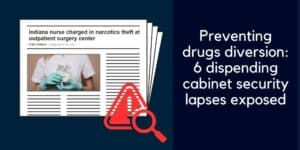In recent years hospitals and healthcare organizations have been embracing technology to improve patient care and boost performance. Introducing automated dispensing systems and automated medication dispensing for the hospital setting provides many benefits over manual systems. As part of the move towards increased efficiencies, hospitals are decentralizing the dispensing function so that it moves closer to the patient and is available at the point of care.
Smart inventory management cabinets located in the OR and Procedure Room setting are resulting in many gains. These automated medication dispensing systems can provide the following benefits.
Benefits of automatic dispensing
Improved patient safety
When automated dispensing cabinets are located within the surgical setting patient safety is improved due to:
- real time alerts at the point of dispensing prevent the use of expired or recalled items
- reduced dispensing mistakes – clinician not pharmacy lead
- dispensing is based on patient need at the point of care
Enabling dispensing to be carried out in real time
Being able to make ‘on the spot’ medication decisions during surgery enables enhanced flexibility and aids more accurate in-surgery record keeping resulting in the:
- tracking of actual not planned utilization
- optimized return of ‘exceptions’ – broken or unused supplies
- removed usage discrepancy disagreements between pharmacists and clinicians
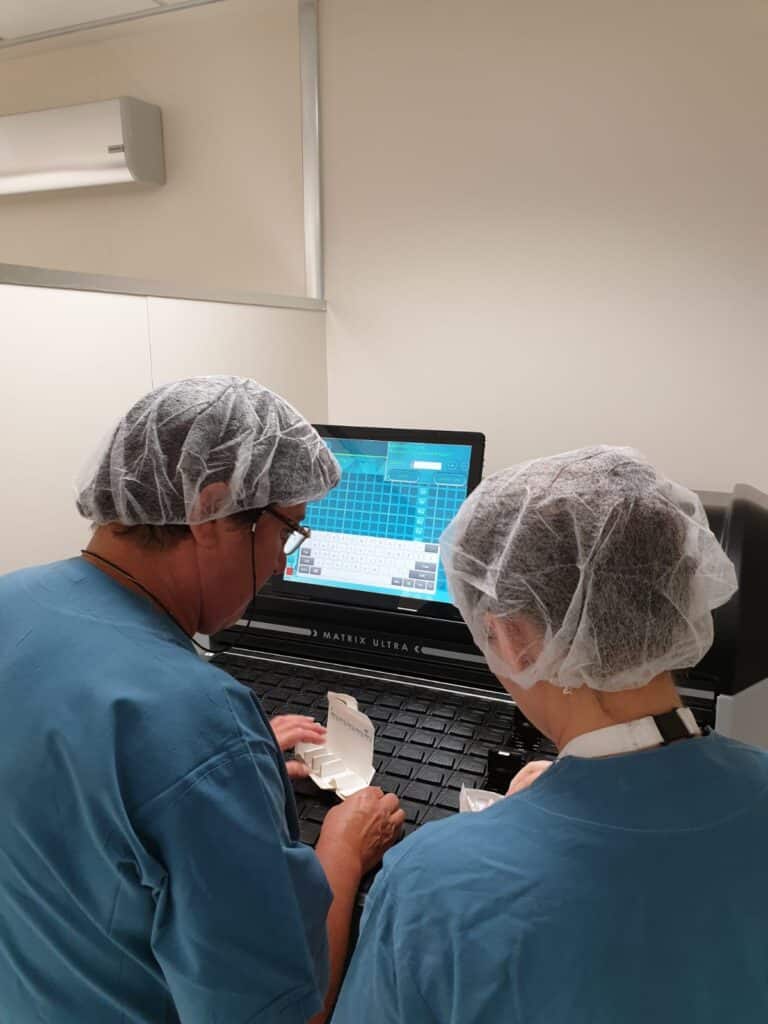
Increased accuracy in dispensing
Dispensing within the OR and Procedure Room tends to be more accurate because:
- dispensing is carried out directly by the clinician -, no misunderstandings, no ‘sound alike’ mistakes
- with an easy to use automated dispensing system there is reduced likelihood of incorrect drug selection
Increased security of controlled, high risk/high cost medications
Narcotics and controlled substances used within the surgical setting tend to be the most cost and health sensitive medications. Ensuring their safe storage and issue required adequate security that:
- limits access to authorized staff only
- reduces loss and wastage
- reduces drug diversion
Improved operational efficiency
When effective systems and workflows are in place there is enhanced clinical, pharmaceutical and management efficiency. Although clinical staff use the automated dispensing cabinet, it is Pharmacy staff that oversee the usage of medication inventory. The automated cabinets in surgical settings provide accurate record keeping so that the management function is effecting. This is largely due to:
- full visibility of inventory
- full tracking of usage
- accurate monitoring of the issuance and administration of narcotic drugs in accordance with the strictest governmental regulatory requirements
- production of reports and data analytics/insights
- interoperability results in end to end pharmacy supply chain workflow
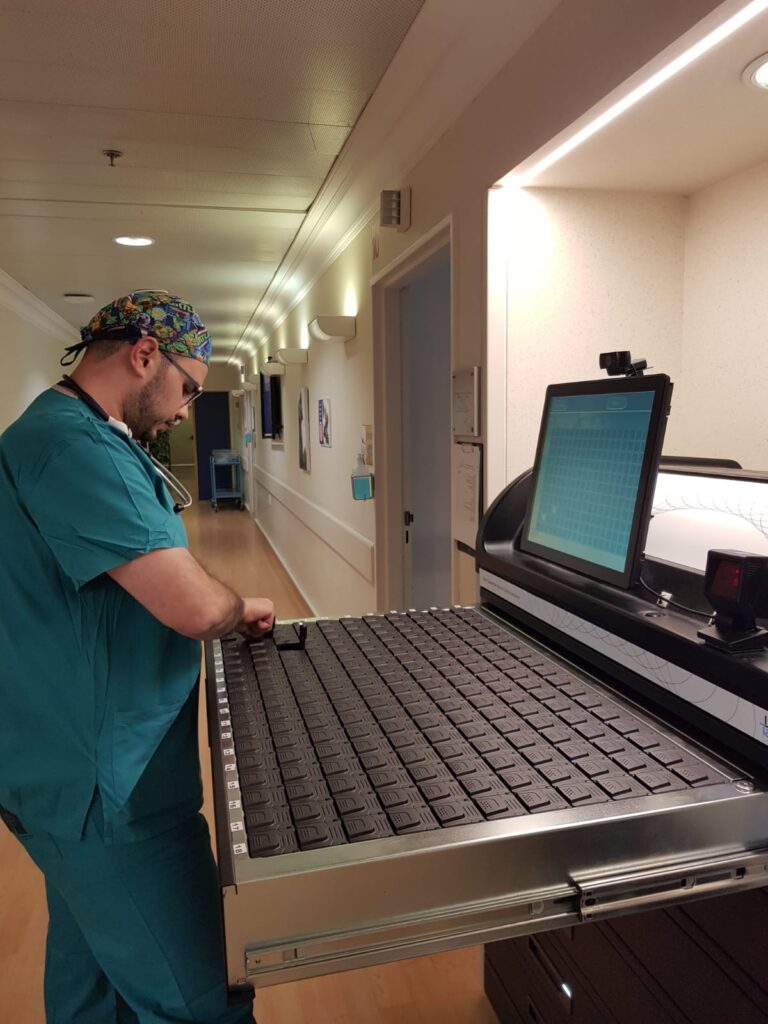
Pharmacy management systems in the hospital setting
Operating Rooms and Procedure Rooms are hectic environments, where staff perform a critical function that supports patient wellbeing. Moving the dispensing of controlled substances and narcotics outside of the pharmacy and into the operating room allows clinicians to take ownership for dispensing to their patients, with the pharmacist retaining responsibility for stock management.
Drugs and pharmaceutical products play an important part in the management of patients undergoing surgery – they are used before, during and after procedures.
Physicians, Nurses and Anesthetists need to respond to the changing needs of their patients during surgery and ensure that the right medication, at the correct dosage is at hand. Having a dispensing system at the point of care that is quick and easy to use gives the clinical team better control and allows them to immediately respond to the patient’s changing needs.
Ultimately, the Pharmacy Department, in collaboration with clinical teams, needs to manage the effective control and distribution of medication across the hospital.
Types of automated dispensing systems
Not all automated dispensing systems are equal. Let’s look at why choosing the right type of automated dispensing system is so key.
Management of the controlled substance inventory
The administration of controlled substances and narcotics inventory is a high-risk area in any healthcare setting and particularly within surgical rooms where the wrong dosage or drug can have dire consequences.
It is a critical workflow where dispensing Physicians or Anesthetists need to comply with drug administration regulations and take extreme care to ensure that the anesthetics and drugs given to patients are suitable.
With prompt and accurate dispensing necessary in OR and Procedure Rooms, there is no longer any place for convoluted processes. There is a lot of scope to tighten up OR drugs dispensing workflows into leaner, less time-consuming and more effective processes which are carried out within the surgical setting and not back at the Pharmacy.
Research shows that automating medication management workflows results in fewer dispensing errors and a reduction of medication administration time and costs.
Automated dispensing system – pharmacy in the perioperative setting
Narcotics cabinets are no longer solely designed for the pharmacy setting. Automated dispensing systems designed for core hospital areas such as the OR and procedural areas, give surgical staff more autonomy and improved, instant access to medications. Automated dispensing cabinets allow medication storage at the point of care and enable easy control, dispensing and tracking.
In the tense clinical setting, when events can suddenly change and urgent drug requests are critical, having a dispensing system on hand that is easy to use is a huge benefit to the perioperative team.
Anesthesiologists and physicians require access to controlled medication during surgery and having a reliable drug dispensing system enables the clinical team to provide the patient with optimum care. Controlled substances need careful logging to comply with drug control regulations and the surgical team benefit from greater security, knowing that all items removed from automated dispensing cabinets are instantly recorded in the system. These smart cabinets capture extensive data that provide a full view of pharmaceutical usage in operating and procedural rooms. Hospitals are seeing real benefits of introducing automated narcotics cabinets in the clinical setting.
Point of care medication dispensing technology ensures that hospitals have optimal workflows with inbuilt safeguards to lower the level of hospital risk and protect patients.
Medication dispensing systems
Automated dispensing systems in pharmacy can be for medication or narcotics dispensing, these two types of dispensing differ in significant ways, primarily in terms of the types of medications and the regulatory requirements involved. Organizations looking for a medication dispensing machine for hospital care need to carefully consider their needs.
- Medication Dispensing: This is a broad term that encompasses the process of providing patients with any type of medication, including over-the-counter drugs (e.g., pain relievers like ibuprofen), prescription medications (e.g., antibiotics), and controlled substances (e.g., opioids like oxycodone). Medication dispensing can occur in various settings, such as pharmacies, hospitals, clinics, and long-term care facilities. In many cases, patients can obtain medications directly from a pharmacist without needing a prescription from a healthcare provider.
- Narcotics Dispensing: This refers specifically to the dispensing of controlled substances, also known as narcotics, which have a high potential for abuse or addiction. Examples include opioids, certain stimulants, and some sedatives. Due to their potential for harm, these medications are subject to stricter regulations and oversight to retain control and prevent misuse or diversion.
The shift away from manual systems towards Automated Dispensing Cabinets (ADCs)
We have already noted the trend away from manual systems in OR and Procedure Rooms but let’s look at a few reasons why.
Manual drug dispensing is prone to human error including:
- the miscommunication of drug names
- prescribing too much or too little medication (under or overdosing)
- difficulty keeping track of used medications during surgery
- physician-centered approach to dispensary management – rather than centralized management approach
- poor visibility of medications inventory
- time consuming manual stock control activities.
- inefficient procurement (overstocks/stock outs)
- lower response times to changing patient medication needs during surgery
- misreporting usage to the Pharmacy post surgery
- failure to identify product expiry
- failure to identify recalled batches
When using manual systems, it just takes a momentary lapse of concentration to make a potentially damaging mistake.
Then there’s the issue of having a system in place to ensure effective ‘sweep up’ – dealing with surplus, unused or damaged stock and ensuring these are returned into storage, recorded as such and also that the patient record contains accurate usage data.
Using old manual systems often hindered the accurate tracking of medications and had the potential to result in the misreporting of patient usage. There would often be disagreements between pharmacists and clinicians as they tried to reconcile the drugs received, used and returned.
Medication expiry management and dealing with product recalls
Hospitals that rely on manual medication inventory systems in OR and Procedure Rooms end up having poor stock visibility. This is because OR and Procedure Rooms are known to be the hardest environment to accurately log usage data. Therefore with data gaps from this setting and others across the hospital, the inventory listing on the hospital system will inevitably be incorrect.
A lot of high risk, high cost narcotics and controlled substances are used during surgery and it is crucial that only safe items are used on vulnerable patients. Lack of stock visibility results in poor stock control and this hampers the vital task of expiry management.
Surgical areas often use expensive drugs that have a very short lifetime. Ensuring that these items are carefully stock controlled with the soonest to expire used first is important for patient safety as well as sound financial management.
When the earliest expiring medications are not selected and dispensed first this causes many problems:
- the issuing of expired items and the potential impact this could have on patient health
- opening up the hospital to expensive litigation
- unnecessary wastage costs
- unnecessary procurement costs
Security within the controlled substance management system
For obvious reasons access to narcotics and controlled substances needs to be closely monitored. Many hospitals don’t have strong enough systems in place to provide adequate security control and this is an important feature to look at when determining the best automated pharmacy management system to use.
There needs to be secure identification features prior to allowing any member of staff to access the dispensing systems. The system should track each person’s individual dispensing record, ensuring that the hospital is 100% sure that adequate controls are in place.
Smart narcotics cabinets in OR and Procedure Rooms limit access to approved staff only and provide safe and secure storage for controlled medications. All staff need to get through the authorized access security and this personal tracking of dispensary usage ensures that each member of staff is held accountable for their dispensing.
Upgrading pharmacy inventory management software
Some hospitals may already have an automated drug dispensing system in place within the OR setting, however in many cases this can be stand alone and may not integrate with other hospital IT systems. This results in staff having to work across multiple systems and carry out repetitive data input. The duplication of tasks in order to update all relevant systems wastes time and creates frustration for busy staff.
Usage data that may need to be entered in multiple systems can include the list below:
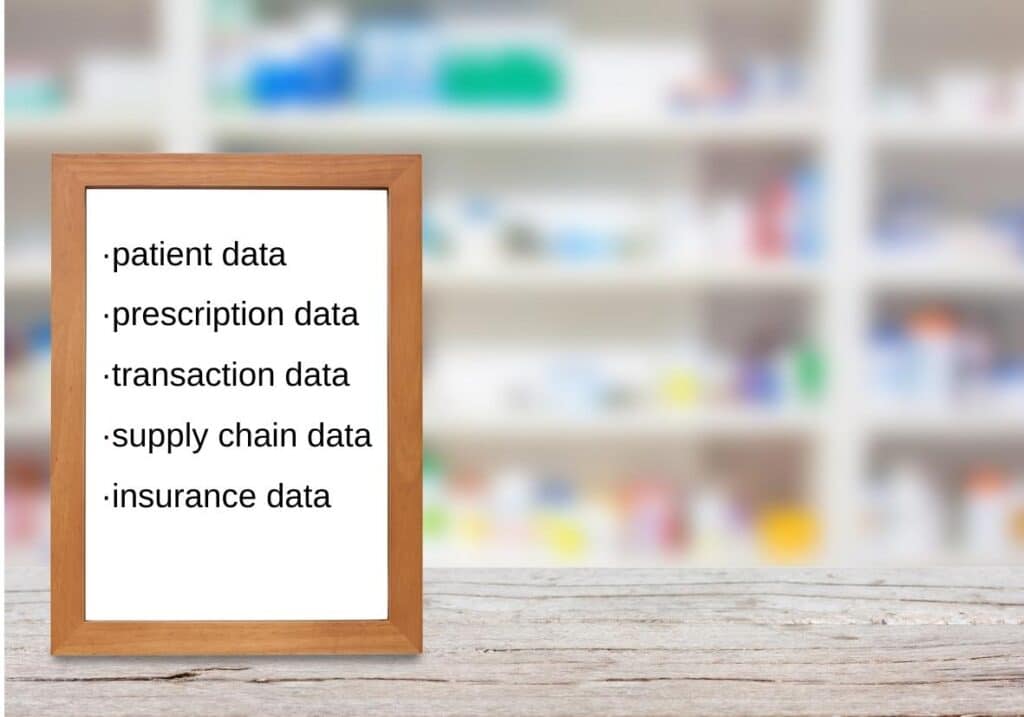
In addition to requiring multiple inputting of data across systems, another facet of older technology is that it will not have the sophisticated analytical ability of modern systems.
Obtaining comprehensive data from pharmacy dispensing systems provides useful data insights for the effective management of the medication supply chain.
By tracking medication inventory the system is able to provide usage data that enhances management ability.
Upgrading to a modern, centrally integrated system that provides meaningful data insights is the best route to effective medication management.
.
Medication management in the pharmacy setting
Hospital pharmacy medication management covers the ordering, storing, dispensing and procurement of pharmaceutical products. Having effective medication management systems within Procedural Rooms and OR ensures the accurate recording of the medication issued to each patient. This data is then communicated to the hospital’s ERP system and the patient’s EHR.
Pharmacy medication management software used in the surgical setting helps complete the supply chain cycle by tracking usage, updating the patient record and hospital management system. The medication journey cuts across many key hospital workflows and requires inter-communication between people and systems. OR and Procedure Rooms, due to their frantic environment, were often weak points in the collection of usage data so having an on-site dispensing system is a big step forward in proper pharmaceutical inventory control and provide visibility of items in stock, when medication was used, which clinician issued it and which patient received it.
Effective hospital medication management systems are part of the pharmaceutical supply chain and visibility across the full supply chain is the secret of success.
Controlled substance inventory is critical for running efficient POC medication management
Management of pharmaceutical inventory is a core hospital function which ensures that patients receive the full range of drugs and medical supplies at the point that they need it. In the surgical setting it is important to ensure that adequate medical supplies are ordered to serve the diverse needs of patients going through critical medical procedures.
The supply chain is a cycle and to work properly the gaps needs to be closed between
- usage and billing
- reimbursement and procurement
Dispensing is just one stage of this cycle but it is an important one that feeds the workflow and, when carried out correctly, can integrate with hospital systems and trigger multiple actions further up the supply chain.
What is Pharmacy Optimization?
Pharmacy optimization, also known as medicine optimization, is an approach to optimize the best possible outcome for patients, based on the safe and effective use of medicines. This complements medicine management which is more concerned with processes and systems.
The onus in pharmacy optimization is patient outcomes and having on-site dispensing within surgical rooms is one way to achieve this.
The multi-disciplinary role of the hospital pharmacy function
Hospital pharmacy services are now more commonly part of the multi-disciplinary team rather than a stand-alone function.

Multidisciplinary working is when different departments in the hospital work together to achieve the best patient care.
Having a multi-team approach is a proven way to help Pharmacists improve patient wellbeing and facilitate appropriate prescribing.
The integration of the hospital Pharmacy function into hospital clinical teams is a huge advantage and best practice is to have the actual dispensing function move from the hospital pharmacy to the Operating Room and Procedure Rooms.
Hospitals that have taken on this approach and achieved a more integrated healthcare. They have improved inter-disciplinary collaboration which in turn can only safeguard patients.
.
Medication is only one aspect of patient care and better integration of hospital pharmaceutical services into the clinical team environment gives clinicians the ability to be more responsive to their patients’ needs at the point of care.
Making sure that the workflows and IT systems are effectively integrated – from the OR room to the ERP and EHR, is crucial to making the joint approach work
How hospitals can leverage pharmacy medication data capture
Pharmacy Departments are a significant contributor to the financial performance of the hospital. It is therefore crucial that they are run in an efficient, cost-effective way and to do this requires solid data and analytics. Some of the most expensive drugs are used during surgery so having an easy-to use dispensing system in situ that accurately tracks in-surgery usage, is an effective way to capture narcotics and controlled substances at the point of care.
Leveraging data is the process of turning raw information, such as drug usage data, into valuable actionable insights. For a hospital pharmacy to be able to successfully leverage data they will first need to have valuable tracking, data capture and analytics in place that not only cover the hospital pharmacy but also cover the OR and Procedure Rooms.
In order to move forward with confidence, hospital pharmacies need smooth workflows with in-built security that save them time and effort. The systems need to provide data analytics that result in meaningful data insights so that management can understand patient medication usage, physician preferences, dispensing trends and use all this data to make informed management decisions on budgets, procurement and more.
Comprehensive, data-driven pharmacy insights, that includes information on point of care usage, informs management thinking and results in insight-led decisions.

Data insights can:
-
-
-
-
-
- Inform fiscal budgeting and planning
-
- measure clinical pharmacy key performance indicators
- improve the management of patients, products, and services
-
-
-
Data analytics are an important tool to help managers to address the specific challenges in the ever-complex hospital pharmacy setting. It is worth checking out the quality of data insights provided by different systems as some can be more comprehensive than others. Having key metrics on hand is a valuable management tool.
Efficient, automated medication dispensing
The pharmacy supply chain is becoming increasingly complex. Having automated dispensary cabinets in hospital procedure rooms provides optimum the Pharmacy Department with usage tracking and leads to better control of stock and budgets.
Medication supply visibility is when the hospital has a system in place that tracks each product, shows the location it is stored in, flags core product data including the expiry date. When the pharmacy inventory is visible in the surgical setting, accurate automation tools can support effective stock control. Having effective stock control in place prevents stock outs and overstocks, as well as contributes expiry management and recall issues.
When stock is over-ordered and the amount of inventory on-hand is too large, this is an indication of poor budget management and the swollen stock levels make inventory management a much more complex task. At the end of the day the hospital’s management of the medication supply chain needs to result in effective medicines management practice.
Within the OR and Procedure Room setting, any action that reduces the potential use of expired or recalled products safeguards patients.
There is huge potential to drastically reduce both costs and losses and increase income when hospitals have the right tools to manage their pharmacy supplies. Automated dispensing cabinets at the point of use accurately track all transactions, leading to more efficient medication billing.
Gaining visibility and automated tracking of the medication and controlled substance inventory enables hospitals to regain control of their pharmacy supply chain. The system works on both an operation and management level – providing insights to enable informed decision making.
Data-driven medication management is the future of hospital pharmacy inventory management – it is based on real stock levels and actual usage. Put simply, facts not fiction.
Pharmacy supplies wastage costs

Medication waste is commonly defined as ‘any pharmaceutical product that remains unused or is not fully consumed throughout the pharmaceutical supply and use chain’.
The cost of drugs is escalating and the careful management of these high-cost supplies is the only way to reduce inventory wastage. Some products have short expiry dates while others are unintentionally overstocked due to poor stock visibility. Having surplus stocks makes effective expiry management a difficult task.
Drug diversion is another issue for hospitals, where healthcare workers divert controlled substances such as opiates away from patients. This could be for sale or personal use. Security systems need to be in place to monitor staff accessing narcotics and controlled substances to prevent stock leakage, reduce financial loss and ensure adequate patient supplies.
.
Poor inventory visibility and weak stock control systems lead to the unnecessary wastage of expired products. This is a massive issue for healthcare providers, with expired medication estimated to cost organizations $800 million a year.
Sustainable pharmaceutical supply
Linked to the issue of pharmaceutical waste is sustainability. The wastage of viable medication cuts an unnecessary slice out of the pharmacy’s medication budget but also goes against the ethos of efficient dispensing.
Minimizing medication wastage is a conservation issue as well as a financial issue. Healthcare organizations can contribute to a more sustainable supply chain by enforcing a waste-minimizing policy. This involves better stock management, improved purchasing and accurate dispensing. It also covers the return and reuse of unopened medication taken from narcotics cabinets.

The management of internal medication waste can be supported by better inventory management including:
-
-
-
- informed procurement to prevent overstocking
- better stock management
- automatized expiry management, with soonest to expire items used first
- optimized dispensing processes
- improved systems to ensure the return of unopened packages
- re-dispensing of unused medication
-
-
High volumes of waste are bad for budgets and bad for the environment. By getting a better grip on procurement and inventory management, wastage levels will drop and the hospital will be better contributing to a more sustainable pharmaceutical supply chain.
.
Controlling the Hospital Pharmacy Budget
There is an upward trend in recent years of healthcare organizations purchasing a greater volume of expensive, higher regulated medications. Hospital pharmaceuticals represent over 18% of the US healthcare budget and about 80% of the average hospital pharmacy budget.
US hospital expenditure on pharmaceutical items exceeds half a trillion dollars a year!
Many hospitals are looking to increase efficiency within the management of hospital pharmacies and to offset rising medication costs against leaner processes that yield savings.
Data driven metrics play a large role in streamlining processes and tightening workflows. Data insights on performance, usage and more will be a vital element in fiscal budgeting and planning.
Hospital management will be looking to achieve improvements such as:
- identification of profitability leakage areas
- full charge capture and accurate billing
- increased revenue and improved growth margins
- improved procurement and reduced or at least contained costs
- streamlined operational processes that lead to improved operational efficiency
- improved staff efficiency including reduced admin time
- safeguards to assure regulatory compliance
- enhanced patient safety and care
- increased protection for staff
- improved financial and clinical performance
Having solid workflows and supply chains in place is therefore important in order to effectively manage this large investment and look to maximize business and operational performance.
Aiming for Zero Error Medications Management

The incorporation of technology into pharmaceutical medicine management is an effective way to reduce avoidable errors. Medication management is an area where there is simply no room for mistakes. Connected medication management technology provides visibility and communication across pharmaceutical and clinical teams.
However the starting point of many is one of disparate IT systems and lack of integration. Using this model it is common place within hospitals that data is manually entered time and again into different systems. Each individual input has room for human error and takes valuable time. Automated processes are simply quicker, more accurate and safer. When dispensing goes wrong patient wellbeing is at stake and litigation is not far behind.
Connecting the medication inventory into hospital systems makes the full stock visible and enables better management and control, as well as makes great strides towards improved efficiency and enhanced patient safety.
Getting it right is an absolute priority and replacing high risk manual workflows with automated processes is the route to zero-error medication management.
.
Strong pharmacy inventory management systems support staff and improve patient care
In many hospitals the current arrangements mean that medication management workflows may be disconnected, run across several IT systems and are often not standardized across the hospital. Staff often have to deal with longwinded and disjointed workflows which may necessitate them undertaking workarounds to complete their tasks. All of this additional administrative effort eats away at pharmacy, physician and nursing time, as well as increases frustration. Moving to an automated, integrated system eliminates repetitive tasks such as inputting and checking as well as reduces waste and errors.
Pharmacists, Physicians and nursing staff work in a hectic environment and have broad job descriptions. Having smart tools at their disposal frees up time for them to focus on patient care, and in doing so improves job satisfaction.
Hospital Staff Retention
Hospitals are currently undergoing immense human resource pressures and operating at critical staffing levels.
After the great resignation of 2021 when over 47 million Americans quit their jobs, retaining skilled staff has taken on even greater importance.
The American Hospital Association (AHA) reported in January 2022 that 23% of hospitals across the US have staff shortages. This has lead to delays in both diagnosis and treatment. Staff shortages put added pressure on the workforce, cause burnout and are a factor in further resignations – so each resignation has a knock on effect to the remaining staff.
Making sure that the staff are happy and have job satisfaction has never been more important. Poor systems and repetitive tasks are disliked by nursing and clinical staff as it removes them from the parts of the job that really matter to them.
Enabling staff to focus on the parts of the job they enjoy and removing daily frustrations will surely play its part in retaining key members of the hospital workforce.
Automated Dispensing Systems Technology
Healthcare organizations are acknowledging the financial, clinical and operational impact that sound data and integrated technology can bring to the table.
The technology being used to manage pharmacy supplies in hospitals includes RFID, bar code scanners and smart bins.
This smart tech is used within automated dispensing systems enabling them to track stock, detect when supply levels are low and inform the supply chain process.
What is a smart dispensing cabinet?
Smart medication cabinets are computerized and served by a cloud-based management system. This enables real time inventory and expiry tracking.
Automated dispensing cabinets (ADCs) are locked medication storage units with access limited to authorized personnel. The dispensing cabinets contain rows of drawers which contain numerous small compartments where each narcotics item or anesthesia ampule is stored.
Interaction from the Pharmacist, Physician, Anesthetist or Nurse is via a screen where patient data is entered and prescribed items are listed.
The selected items only are then made available by a specific drawer opening and then a specific compartment. The system only allows access to items on the patient’s medication log.
Using automated dispensing systems provides security to the user as it has built-in checks that protect the patient.
Benefits of an automated dispensing cabinet
Using an automated medication dispensing system helps pharmacists and clinical staff to get the correct medication to the right patient. It provides a level of protection in the managing of medications and saves valuable time too – staff can remove items quickly and with confidence. It’s the smarter, safer way to
- increased security – medications are locked into cabinets which can only be accessed by specific personal using their ID to gain entry.
- audit trail – narcotics and controlled substances are electronically tracked, with a full audit trail available of the staff member accessing the items and the patient receiving them.
- informed procurement – tracked inventory results in restocking based upon usage.
- data integration – with EHR, ERP for the fast flow of data down the workflow.
- safety features to ensure selection of drug matches prescribes medication.
- expiration date tracking ensures usage of earliest to expire items plus it prevents errors and wastage.
Smart narcotics cabinets boost pharmacy dispensing efficiency and provide patient safeguards. They are far superior to manual dispensing and save valuable time.
Hospital pharmacy and clinical staff utilizing automated dispensing units provide positive feedback in relation to ease of accessing and recording drug use.
Features of an Automated Narcotics Cabinet
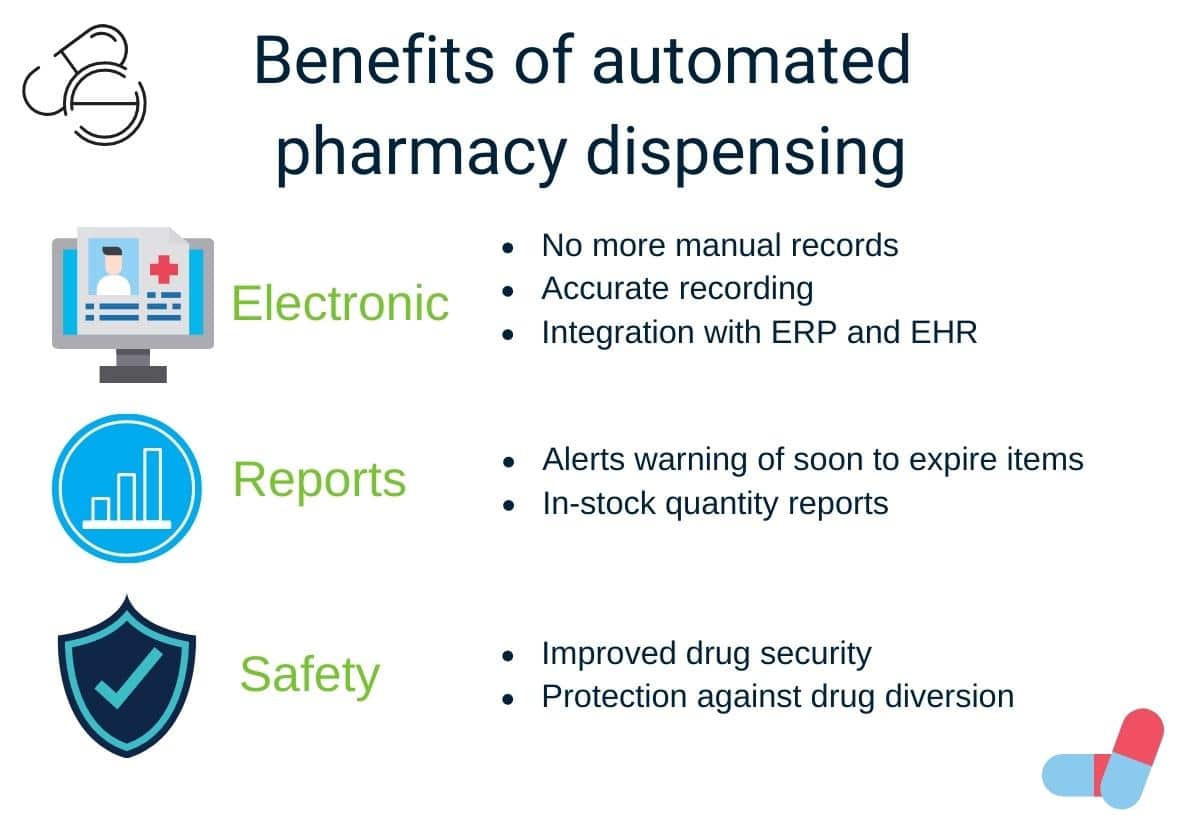
In order to lower risk and improve financial, clinical and performance outcomes hospitals are increasingly looking to leverage technology and best practice.
There is a clear understanding by an increasing number of hospitals of the value of better medication inventory visibility, in-built risk-protections and data analytics.
Smart cabinets are easy to use and provide security and reassurance to staff and the organization.
They integrate across the hospital setting and communicate with hospital software, integrating pharmacy into the wider hospital processes.
Narcotics cabinets make good business sense. They can control costs, make savings and boost income, showing a good return on investment.
The Best Fit Narcotics Cabinet for your Hospital – from IDENTI Medical
IDENTI Medical is an expert in medical data sensing products. We have developed a Secured Narcotics Cabinet which gives hospitals a management system for controlled substances and narcotics.
IDENTI have created the next generation of Narcotics Cabinet. Powered by AI software, it’s packed with enhanced features to fully meet the needs of hospital medication dispensing.
The IDENTI Narcotics Cabinet:
- can be used in hospital pharmacies, operating rooms and other core hospital areas.
- provides the only solution on the market that ensures full reconciliation of drug administration regulations.
- is a simple interface reflects the three core actions required: Take, Return, Waste.
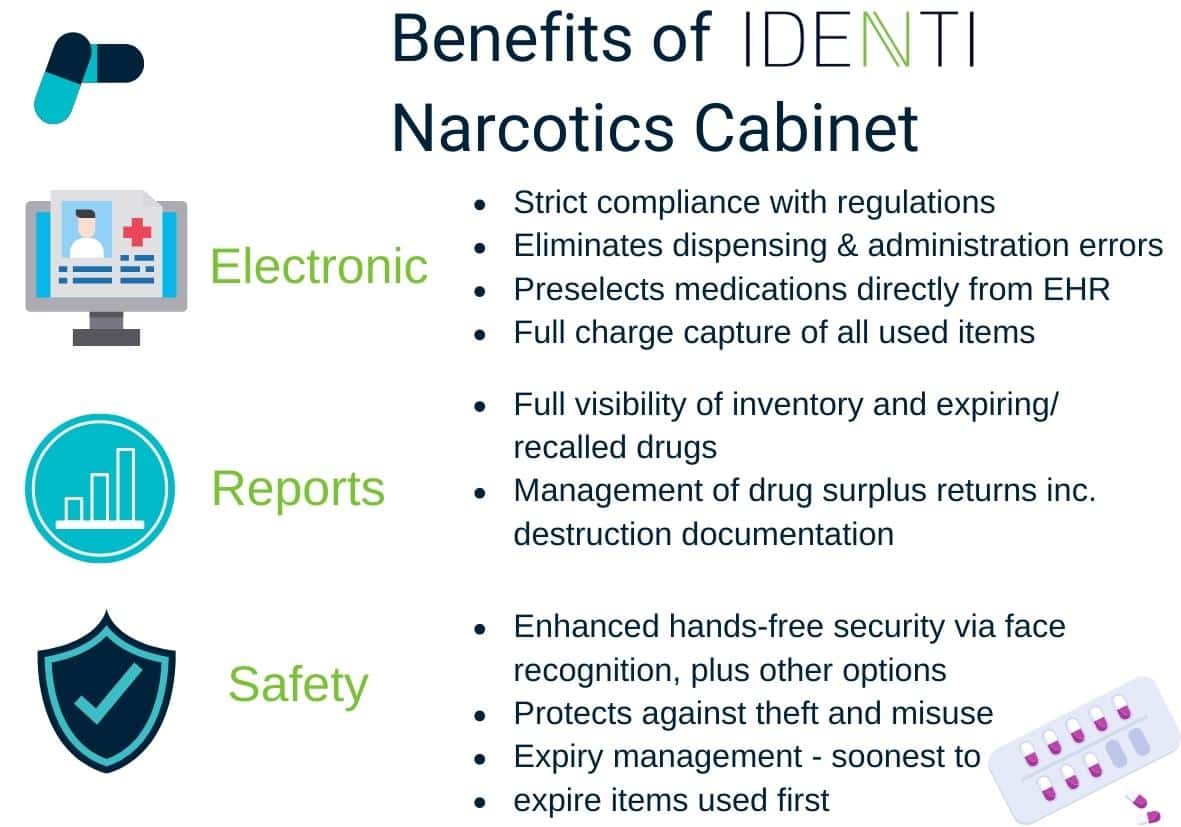
.
.
IDENTI makes managing medication a simpler, safer task.
Medication Dispensing System
Automated dispensing systems (ADS) are computer-controlled systems that automate the dispensing of medications in hospitals. ADS systems can help to improve patient safety, increase accuracy, and improve operational efficiency. They can also help hospitals comply with drug administration regulations.
Some of the benefits of using ADS systems include:
- Reduced risk of medication errors
- Improved medication adherence
- Increased efficiency and productivity
- Reduced labor costs
- Improved inventory management
- Enhanced compliance with drug administration regulations
ADS systems are typically used in hospital pharmacies, but they can also be used in other healthcare settings, such as nursing homes and long-term care facilities.
If you are interested in learning more about ADS systems, I recommend that you visit the website of the American Society of Health-System Pharmacists (ASHP). ASHP has a number of resources available on ADS systems, including a white paper on the benefits of ADS systems and a guide to selecting and implementing an ADS system.


